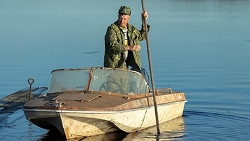 The Sydney Film Festival reviewed the Philippine entry “FromWhat is Before?” by Lav Diaz as a five and half hour hauntingly beautiful new picture .
The Sydney Film Festival reviewed the Philippine entry “FromWhat is Before?” by Lav Diaz as a five and half hour hauntingly beautiful new picture .
“From What Is Before” will be screened during the Sydney Film Festival on Sunday 14 June at Dendy’s Quay Cinema in Sydney.
The film chronicles the gradual decline of a small coastal barrio in the Philippines in the final days before president Ferdinand Marcos imposed martial law in the Philippines.
“ At once a vital work of historical reclamation and a sort of Southeast Asian companion piece to Michael Haneke’s “The White Ribbon” — another stark, black-and-white drama about mysterious acts of evil befalling a fragile community — this endlessly patient and contemplative work will court a smaller audience than Diaz’s Cannes-premiered international breakthrough, “Norte, the End of History,” but should exert a strong pull on viewers willing to stick it out. Following Locarno (where the film won the Golden Leopard) and Toronto, fests will continue to feel the Lav.
“From What Is Before” is a slow-cinema auteur known for Diaz’s epic running times. It is a longer sit than “Norte” (250 minutes) but a brisk jaunt compared with the likes of “Melancholia” (450 minutes), “Death in the Land of Encantos” (538 minutes) and “Evolution of a Filipino Family” (593 minutes).
SSF continues, “As ever, the effectiveness of Diaz’s approach depends on his finding a subject worthy of sustained rumination, and in this film, which he aptly describes as “a memory of a cataclysm,” it is the very act of remembering, of recalling the specific texture and atmosphere of his lost childhood, that seems to determine the duration of every shot and the placement of every cut. A poet-historian of longform cinema, Diaz seeks not merely to relay a series of events, but to draw us into a fully inhabited world.
“Diaz films his landscapes in monochrome master shots that can stretch on uninterrupted for minutes, lingering on the sight of a bull roaming the jungle freely, or craggy rock formations that serve as a bulwark against a violently churning sea. The fragile interplay of nature and civilization is best expressed in the way Diaz frequently sets the stage for each scene, allowing us to absorb the contours and details of every location before ever so gradually introducing human characters, looking small and ant-like, into the frame.
“These are people who deeply understand the degree to which they rely on the land, and also the extent to which they are at its mercy.







Leave a Reply